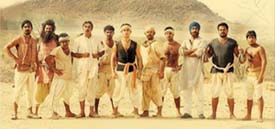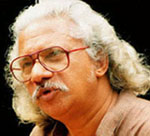The Lagaan lesson
By P K Ravindranath | 28 Mar 2002
 Lagaan was
not nominated for an award in any category: for direction,
cinematography, screenplay and settings not even for sound
recording. It is yet to make a mark at any major film festival.
The film that won in the category of the Best Foreign Language
Film, No Mans Land, had already won the Golden Globe for
Best Foreign Language Film, best screenplay at Cannes and an EFA,
as well as nominations for the Golden Palm at Cannes and two
Cesars.
Lagaan was
not nominated for an award in any category: for direction,
cinematography, screenplay and settings not even for sound
recording. It is yet to make a mark at any major film festival.
The film that won in the category of the Best Foreign Language
Film, No Mans Land, had already won the Golden Globe for
Best Foreign Language Film, best screenplay at Cannes and an EFA,
as well as nominations for the Golden Palm at Cannes and two
Cesars.
The nomination for the Oscar, however, had been fully exploited by the producers to re-launch the release of the film not only in India for a second run, but also in many other countries where Indians live in sizeable numbers.
Financially thus, the nomination has done the film a world of good. And by all accounts, Khan and his team have done a remarkably good job in exploiting the situation to their advantage. Reports indicate that the film would get a commercial release in the US itself, despite the hype and debacle at the Oscars.
The theme of
the film is such that it would not in any case have found favour
with the Anglo-Saxon organisers of the Oscar awards. A bunch of
illiterate, rustic characters challenging the might of the great
British Empire and winning against all odds? Why should the
Anglo-Saxon breed in any way encourage and promote such a film and
infest it with a greater glory?
This is not trying to promote a concept or dubbing the grapes sour
after eating them. Nor is it an attempt at being chauvinistic.
There have been a number of excellent Indian films, particularly
in Hindi and Malayalam, which have been entered for some of the
major film festivals abroad. Except for Cannes and some of the
minor ones, none of them have been lauded or decorated, though at
least some of them deserved to be.
 Adoor
Gopalakrishnan is one among the few persistent filmmakers in
Malayalam who has taken almost all his feature films and several
documentaries to almost all the major festivals in the west. His
films have made a major mark at some of the greatest film
festivals in Asia and even in Latin America, but not in the
northern hemisphere. In fact, my private joke at Adoors cost
has been that he makes one film in five years and spends four
years in taking it around all major film festivals. A number of
his films have won all the major festival awards in India
including the national and state awards for best film, direction
and for other technical excellence.
Adoor
Gopalakrishnan is one among the few persistent filmmakers in
Malayalam who has taken almost all his feature films and several
documentaries to almost all the major festivals in the west. His
films have made a major mark at some of the greatest film
festivals in Asia and even in Latin America, but not in the
northern hemisphere. In fact, my private joke at Adoors cost
has been that he makes one film in five years and spends four
years in taking it around all major film festivals. A number of
his films have won all the major festival awards in India
including the national and state awards for best film, direction
and for other technical excellence.
The subtle Anglo-Saxon spirit comes alive in the selection of No Mans Land for the award for the best Foreign Language Film. It revives memories of heroism of American soldiers and marines, leading the NATO forces in ending the Bosnian conflict. Osama bin Laden be damned, but the valiant Americans can still do it in Bosnia.
Lagaan was too long 100 minutes longer than what foreign audiences are usually accustomed to. It had heady music, no doubt, but it must have sounded unfamiliar to many American spectators. Cricket is not the favourite Yankee game; it is baseball. The finer nuances of the game would have gone beyond the heads of the average American spectator.
The greatest appeal of the film, however, was the tremendous audience participation that it elicited in its screenings in India. Rarely has any other Indian film attained this level of spontaneous reaction from audiences.
One would suspect that even the award for the Best Foreign Language Film was grudgingly given to one Taiwanese and three Japanese films more for political reasons than for artistic merit. The three Japanese films, no doubt, deserved the award. They were: Roshomon (1951), Gate of Hell (1954) and The Legend of Musashi (1955).
Iran has recently emerged on the world cinema stage in a big way, with significantly social films, surprising from a country under the heels of the khomenis and the mullahs. They are bold, technically superb and highly imaginative. Iranian films have been a rage at the Mumbai International Film Festival for the last two years. It had also made a significant mark at the International Childrens Film Festival at Hyderabad.
Korea and China have also come out with good films. Right now what the Oscar awards jury would be looking for are more films like No Mans Land, which would apply salve to the American Rambo image, badly hurt with the crash of the World Trade Center.
 Lagaan,
of all current films in Hindi, was a significant departure from
the beaten path. It left room for tremendous audience
participation for almost three hours of its total running time.
Very few other Indian films had attained this level of spectator
participation. There have been many other films that have touched
the emotions of audiences in a bigger way and there was Albela,
which also prodded audiences to dance to its heady tunes and dance
steps. But the experience of Lagaan was different, and more
intimate.
Lagaan,
of all current films in Hindi, was a significant departure from
the beaten path. It left room for tremendous audience
participation for almost three hours of its total running time.
Very few other Indian films had attained this level of spectator
participation. There have been many other films that have touched
the emotions of audiences in a bigger way and there was Albela,
which also prodded audiences to dance to its heady tunes and dance
steps. But the experience of Lagaan was different, and more
intimate.
All that did not add up to even the consolation also-ran Oscar award for a foreign language film. The experience of Lagaan should open our eyes to the fact that no Indian film would be considered worthy of an Oscar unless the jury has tremendous socio-political compulsions, forcing it to recognise the award-worthiness of an Indian film.
 Lagaan
was made
at a cost of Rs 25 crore (US $5 million). It has, till
now, fetched for its producer a total of about $16 million.
The publicity it has generated due to the Oscar competitive
entry will ensure its run for another six months, yielding
another round of cash flow. With globalisation, it would
be even harder for any Asian film to barge into the American-European
markets. Winning an Oscar for intrinsic merits of a film
will be even harder.
Lagaan
was made
at a cost of Rs 25 crore (US $5 million). It has, till
now, fetched for its producer a total of about $16 million.
The publicity it has generated due to the Oscar competitive
entry will ensure its run for another six months, yielding
another round of cash flow. With globalisation, it would
be even harder for any Asian film to barge into the American-European
markets. Winning an Oscar for intrinsic merits of a film
will be even harder.
Filmmakers in Asia and the developing world have now to give a thought to organising Asian-African Oscar awards of their own. Such an organisation should also eschew the kind of socio-political compulsions that guide the Oscar awards.